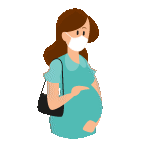Are you and your partner trying to conceive? Understanding your body's fertility signs and recognising your fertile window can significantly boost your chances of getting pregnant. While having regular intercourse increases the likelihood of conception, being aware of your menstrual cycle and ovulation patterns can be invaluable.
Here are five tips to help you pinpoint the best time for conception
Know Your Cycle
Familiarise yourself with your menstrual cycle to identify your fertile window. Typically, ovulation occurs around the middle of your cycle, about 14 days before the start of your next period. However, if your cycle is longer or shorter, ovulation may occur earlier or later. Tracking your cycle for a few months can help determine your ovulation pattern.
Use Ovulation Predictor Kits
Ovulation predictor kits are available over the counter and can help you predict when you're about to ovulate. These kits detect the surge in luteinizing hormone (LH) that occurs 24 to 36 hours before ovulation. To use these kits, simply follow the instructions on the package and test your urine daily around the time you expect to ovulate.
Monitor Basal Body Temperature
Your basal body temperature (BBT) is your lowest body temperature at rest, which typically increases slightly after ovulation due to hormonal changes. By tracking your BBT daily with a basal body thermometer, you can identify the slight temperature rise that occurs after ovulation. To use this method effectively, take your temperature every morning before getting out of bed and record it on a chart. A sustained temperature increase of about 0.5 to 1.0°F indicates that you've ovulated, signalling the end of your fertile window.
Observe Changes in Cervical Mucus
Pay attention to changes in your cervical mucus throughout your cycle, as it can provide valuable clues about your fertility status. Around ovulation, cervical mucus becomes clear, slippery, and stretchy. This fertile cervical mucus helps sperm travel through the cervix and into the uterus more easily. By monitoring these changes, you can identify when you're most fertile and plan intercourse accordingly.
Lower Abdominal Pain
Have you ever noticed pelvic pain in between your cycles?
Experiencing lower abdominal pain, often referred to as Mittelschmerz pain, can be a sign of fertility for some women. This sensation, typically felt during the middle of the menstrual cycle, manifests as sharp, cramping pain in the lower pelvic region. Lasting anywhere from a few minutes to several hours, it often coincides with ovulation, signalling that an egg is being released from the ovary. However, it's important to note that not all women experience this pain, and its absence does not necessarily indicate infertility. Each woman's body responds differently, with some experiencing mittelschmerz regularly while others never do.
Irregular periods can pose a challenge when trying to conceive, as they may indicate underlying hormonal imbalances. Seeking guidance from a healthcare provider, such as a gynaecologist, OB, or fertility specialist, is crucial for understanding the root cause of irregular menstruation and exploring potential solutions. Additionally, preconception counselling offers valuable insights into optimising fertility and increasing the likelihood of a successful pregnancy.
Remember, if conception hasn't occurred within a reasonable timeframe, consulting with a medical professional is recommended.
FAQ's
Q. Why is understanding your menstrual cycle important when trying to conceive?
Ans.Understanding your menstrual cycle helps pinpoint your fertile window—the days you're most likely to conceive. Ovulation usually occurs around day 14 of a 28-day cycle. By tracking your cycle over time, you can estimate when ovulation happens, making it easier to time intercourse and increase the chances of pregnancy.
Q. How do ovulation predictor kits work?
Ans.Ovulation predictor kits (OPKs) detect the luteinizing hormone (LH) surge that occurs 24–36 hours before ovulation. You test your urine using these kits around your estimated ovulation day. A positive result means ovulation is likely imminent, allowing you to plan intercourse during your most fertile period for better conception outcomes.
Q. What is basal body temperature, and how does it relate to ovulation?
Ans.Basal body temperature (BBT) is your resting temperature, which slightly increases after ovulation due to hormonal changes. Tracking your BBT daily helps confirm ovulation has occurred. A sustained rise of about 0.5 to 1°F signals the end of your fertile window, helping you better understand your ovulation pattern over time.
Q. How can changes in cervical mucus help track fertility?
Ans.Cervical mucus changes throughout your cycle. Around ovulation, it becomes clear, slippery, and stretchy—similar to raw egg whites. This fertile mucus helps sperm move more easily through the cervix. Monitoring these changes is a natural way to identify your fertile window and time intercourse accordingly for better chances of conception.
Q. What is Mittelschmerz and how can it signal ovulation?
Ans.Mittelschmerz is a term for ovulation pain—mild cramping or discomfort in the lower abdomen occurring mid-cycle. It can last from a few minutes to hours and often indicates the release of an egg. While not all women experience it, its presence can help some identify when they're ovulating naturally.
Q. Can irregular periods affect fertility and conception?
Ans.Yes, irregular periods can make it harder to track ovulation and may indicate hormonal imbalances or conditions like PCOS. If your cycles vary widely, it’s wise to consult a healthcare provider. They can help identify the underlying issue and guide you with treatments or fertility planning options.
Q. What is the fertile window and how long does it last?
Ans.The fertile window is the 5–6 day period leading up to and including ovulation, when you're most likely to conceive. Sperm can live in the body for up to 5 days, while an egg survives for 12–24 hours. Timing intercourse during this window maximizes the chance of fertilization.
Q. Should you have intercourse every day during the fertile window?
Ans.Daily intercourse isn't necessary and can sometimes reduce sperm count. Instead, try having sex every other day during the fertile window. This ensures fresh, healthy sperm are available when ovulation occurs, which is ideal for conception without putting pressure on the relationship.
Q. How long should you try before seeking medical advice for fertility?
Ans.If you're under 35 and have been trying to conceive for over a year without success, it's time to see a fertility specialist. For women over 35, seek help after six months. Early evaluation can help identify potential issues and offer solutions or treatments to support conception.
Q. What role does preconception counselling play in fertility planning?
Ans.Preconception counselling provides guidance on optimizing fertility through lifestyle changes, medical assessments, and addressing reproductive health issues. It can help identify potential risks, recommend supplements like folic acid, and support couples in making informed decisions for a healthy pregnancy journey.




















